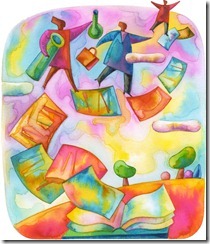Elements of a Book Phenomenon (Part Two)
 In part one of a two-part series examining what transforms a book series into a cultural phenomenon, I identified three such series: Harry Potter, Twilight, and with its March 23, 2012, debut as a major motion picture, The Hunger Games. Each one contains common story elements that transformed them into literary sensations.
In part one of a two-part series examining what transforms a book series into a cultural phenomenon, I identified three such series: Harry Potter, Twilight, and with its March 23, 2012, debut as a major motion picture, The Hunger Games. Each one contains common story elements that transformed them into literary sensations.
If you aspire to write the next book phenomenon, you should consider adding the following elements to your story.
Warning — this post includes a few plot spoilers.
Genres: The series should be in the Young Adult genre with crossover appeal to an adult audience. It should attract readers from both genders. It should have elements of Speculative Fiction (Fantasy or Science Fiction) with Romance between the lead character and one or more supporting characters. Love triangles work.
- Harry Potter: Young Adult and Fantasy with Romance in the later books.
- Twilight: Young Adult, Fantasy, and Romance.
- Hunger Games: Young Adult, Fantasy, and Romance in the first two books.
Setting: The setting should involve contemporary society with elements of fantasy. If the story is set in the future, it should be realistic enough to appeal to a large audience.
- Harry Potter: A magical world co-exists with the muggle (human) world of Great Britain.
- Twilight: Vampires and werewolves co-exist with humans on the Olympic Peninsula in Washington State.
- Hunger Games: Post-apocalyptic world set in the former United States with remnants of American culture.
Protagonists: The lead character must be young with a strong personality and power(s) that makes them special, yet human with vulnerabilities that make them unforgettably unique. Readers should be able to identify personally with the protagonist.
- Harry Potter: Harry Potter, the boy wizard.
- Twilight: Bella Swan, a girl with a unique connection to vampires and werewolves.
- Hunger Games: Katniss Everdeen, a girl who possesses extraordinary survival skills that help her thrive in a post-apocalyptic world.
Supporting characters/sidekicks: The protagonist should have close, loyal friends who will help him or her achieve an epic goal and defeat a formidable foe. They may be romantically involved with the lead character. A trio usually works, and both genders should be represented. The three should have distinct personalities but be compatible.
- Harry Potter: Hermione Granger and Ron Weasley.
- Twilight: Edward Cullen and Jacob Black.
- Hunger Games: Peeta Mellack and Gale Hawthorne.
Sage: The series should include a sage who helps guide the protagonist and their friends on a quest. The sage need not be old, wise, or male; they simply have to be the primary source the protagonist turns to for guidance.
- Harry Potter: Albus Dumbledore.
- Twilight: Carlyle Cullen.
- Hunger Games: Haymitch Abernathy.
Family tragedy: The protagonist should experience a major family tragedy, perhaps losing a parent or both parents, which forces them to seek revenge, retribution, or reconciliation. Although the tragedy should be dramatic enough to build sympathy for the character, the emotional scars should not be too great for the character to overcome.
- Harry Potter: Harry lost both parents.
- Twilight: Bella’s parents divorced; she moved in with her father who had little experience caring for children.
- Hunger Games: Katniss’ father died in a mine blast, leaving her to care for her mother and sister.
Strong villain: The antagonist should be a strong and memorable personality at the center of the protagonist’s struggle. There may be more than one antagonist in the series, but one should be the principle villain. They should have at least one redeeming trait or quirky behavior that makes them appealing to readers.
- Harry Potter: Voldemort / Tom Riddle.
- Twilight: Aro the Volturi.
- Hunger Games: President Coriolanus Snow.
Coming of age: The protagonist needs to grow up and mature as the series progresses in a literary rite of passage. It’s better to start the story when the character is younger so that by the end of the series they have reached adulthood.
- Harry Potter: Seven books; each one representing an academic year at Hogwarts School.
- Twilight: In the first book, Bella is a 17-year-old high school student. In the final book, she is an adult and married with child.
- Hunger Games: Katniss is 16 in the first book and 18 by the end of the series. Each book shows her rite of passage from innocence to fighting in the Hunger Games and leading a rebellion.
Epic tension: The story should include an epic quest, conflict, struggle, or tension that drives the story. Good versus evil is an old standby that works, but the story can also involve shades of gray that address contemporary moral and ethical issues. The story should have a decisive goal that, if met, will resolve the conflict.
- Harry Potter: A good versus evil struggle between Harry Potter and Voldemort that turned gray when they learned that they shared a magical bond.
- Twilight: A human entering the world of vampires and werewolves disturbed their fragile truce and violated accepted laws and customs. The imbalance led to an epic struggle to find a new equilibrium.
- Hunger Games: A good versus evil struggle between Katniss Everdeen and President Snow. Growing up in a violent, oppressive world, Katniss was thrust into a struggle against the existing world order that culminated in an epic battle between the Capitol and the rebels.
Action and emotion: The story should balance action and emotion. It’s no coincidence that Harry Potter, Twilight, and The Hunger Games were written by women who excelled at bringing out the emotion and affection in their characters and as well as delivering action and adventure needed to move the plot. Each deals with difficult topics such as death; at least one major character dies or is near death in all three.
- Harry Potter: Dating and the deaths of several major characters.
- Twilight: Dating, marriage, child-birth, and some deaths.
- Hunger Games: Dating and the deaths of several major characters.
Original reinterpretation of popular themes: The series should exploit a theme in popular culture that appeals to readers. All three reinterpret familiar stories in an original way that attracts a large audience. Many of the authors’ ideas are not new, but the way they package them is new and exciting to readers.
- Harry Potter: British history, magic, myths and legends.
- Twilight: Myths and legends, particularly about vampires and werewolves.
- Hunger Games: A post-apocalyptic world, war, and reality TV.
These are a few of the story elements common to the Harry Potter, Twilight, and The Hunger Games. Adding them to your own story won’t guarantee that it will be the next major book phenomenon, but they will improve your odds. If you plan to write an epic series, make sure that you’ve included all of them in your story. Rather than mimicking their elements, try something new, and you might just find yourself on the cusp of the next big literary sensation.
This is part two of a two-part series examining what transforms a book series into a cultural phenomenon. Click here to read part one.
M.G. Edwards is a writer of books and stories in the mystery, thriller and science fiction-fantasy genres. He also writes travel adventures. He recently published a collection of short stories called Real Dreams: Thirty Years of Short Stories available as an ebook and in print on Amazon.com. His upcoming book, Kilimanjaro: One Man’s Quest to Go Over the Hill, will be released on March 31, 2012. He lives in Bangkok, Thailand with his wife Jing and son Alex.
For more books or stories by M.G. Edwards, visit his web site at www.mgedwards.com or his blog, World Adventurers. Contact him at me@mgedwards.com, on Facebook, on Google+, or @m_g_edwards on Twitter.
© 2012 Brilliance Press. All rights reserved. No part of this work may be reproduced or transmitted without the written consent of the author.

